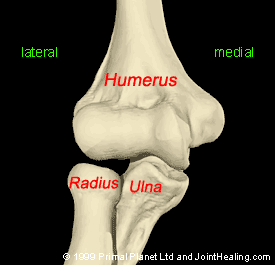There are few things in life that are more enjoyable than watching a little league baseball game on a sunny summer afternoon. There’s the pure enjoyment of the game and that faint flicker of hope that your son, or mine, is the next great Cy Young, and he’s standing on the mound.
In regard to sport, one of the most important things we can do as parents and coaches is to help our kids and players avoid injury. Proper preseason conditioning and in-season training are two ways to achieve this goal. Unfortunately, one common factor that is often overlooked in youth baseball is the type of repetitive injury that our pitchers too often encounter; an injury known as Little League Elbow.
Anatomy of the Elbow:
To better understand medial epicondylitis (Little League Elbow), it helps to understand the anatomy of the elbow. The elbow consists of 3 bones: Humerus (large, long bone in upper arm), Radius & Ulna (forearm bones). Muscle, ligaments and tendons hold the elbow joint together. In children, the bone ends have areas called physes (growth plates) where the bone grows.

What is it?
Little League Elbow Syndrome refers to the pain that occurs in the medial aspect of the elbow due to stress from the repetitive throwing motions in young athletes. Repetitive overhead throwing places traction inside the medial elbow, while creating compression on the lateral elbow. The repetitive traction at the medial elbow pulls at the growth plate becoming an irritant and creating inflammation, also known as apophysitis. Repetitive pulling can tear ligaments and tendons away from bone, and may pull off tiny bone fragments. If this is allowed to continue, a permanent enlargement of the knobby bump on medial aspect of the elbow will occur. This anatomical change can then lead to chronic medial elbow pain.
Symptoms:
A child should stop throwing if any of the following symptoms appear:
- Elbow pain (especially at the knobby bump on the medial aspect of the elbow)
- Seen more often during cocking and/or acceleration phases of throwing.
- Restricted range of motion
- Locking of the elbow joint
- Swelling
- Redness
- Warmth
- Pain with gripping or carrying heavy objects
Prevention:
- Always warm up before pitching with light aerobic exercise
- Always stretch muscles slowly and gently before pitching
- Learn and practice the rules of good mechanics
- Muscles, tendons, and ligaments need “warm up before activity” and “cool down” after activity.
- Have a coach or parent count pitches
- At the first sign of elbow pain, stop throwing, and see doctor for an evaluation
- Play with 1 team during a season
- Baseball pitchers should compete no more than 9 months a year and use 3 months to rest and recover.
- Young baseball pitchers who throw sliders or curveballs have an increased risk of developing elbow and shoulder pain.
- Breaking pitches should not be thrown until reaching skeletal maturity (closure of growth plates)
- Pitchers of all ages should be involved in year-round conditioning to promote endurance, core strength, neuromuscular control, and proper throwing mechanics.
Maximum Pitch Counts According to Age Range
[table responsive=”yes”]| Recommended Limits for Pitchers | Pitches Per Game | Pitches Per Week | Pitches Per Season | Pitches Per Year |
|---|---|---|---|---|
| 9-10 years old | 50 | 75 | 1000 | 2000 |
| 11-12 years old | 75 | 100 | 1000 | 3000 |
| 13-14 years old | 75 | 125 | 1000 | 3000 |
Age Recommendation for Learning Various Pitches
[table responsive=”yes”]| Age | Pitch Type |
|---|---|
| 8 | Fastball |
| 10 | Change-Up |
| 14 | Curveball |
| 15 | Knuckleball |
| 16 | Slider, Forkball, Splitter |
| 17 | Screwball |
Treatment:
- Stop playing upon onset of pain
- Ice should be applied for 15-20 minutes
- Wrap elbow in elastic bandage/compression sleeve
- Usually takes up to 4-6 weeks for proper healing for minimal injuries. Recovery time ranges can go up to 6 weeks-3 months for severe injuries.
- Physical rehabilitation-after pain has subsided, begins with strengthening exercises for arm and range of motion exercises for elbow
- Gradual Return to Pitching
Little League elbow is easy to prevent if the points of prevention listed above are followed. Most of these cases result in minimal loss of time from sport. But if this condition is ignored and allowed to continue it can permanently prevent what could have been a “Cy Young” career.
PLAY BALL!!!!!
References:
American Sports Medicine Institute: USA Baseball Medical & Safety Advisory Committee Guidelines: May 2006, http://www.asmi.org/asmiweb/usabaseball.htm.
Burkhart SS, Morgan CD, Kibler WB: The Disabled Throwing Shoulder: Spectrum of Pathology Part III: The SICK Scapula, Scapular Dyskinesis, the Kinetic Chain, and Rehabilitation. Arthroscopy: The Journal of Arthoscopic and Related Surgery 19(6): 641-661, 2003.
Cain LE, Dugas JR, Wolf RS, Andrews JR: Elbow Injuries in Throwing Athletes: A Current Concepts Review. The American Journal of Sports Medicine 31(4): 621-635, 2003.
Hang DW, Chao CM, Hang YS: A Clinical and Roentgenographic Study of Little League Elbow. The American Journal of Sports Medicine 32(1): 79-84, 2004.
Lyman S, Fleisig GS, Andrews JR, Osinski ED: Effect of pitch type, pitch count, and pitching mechanisms on risk of elbow and shoulder pain in youth baseball pitchers. The American Journal of Sports Medicine 30(4): 463-468, 2002.


About The Author: Michael Pinckney, D.C.
Dr. Michael Pinckney founded Complete Rehabilitation in October of 2000. He, his wife Stacie and their three sons live in the area and are involved in many community based activities. Dr. Pinckney has received numerous civic awards including “The Rotarian of the Year”, the LGBA Presidents Award and the 2010 West Suburban Chamber of Commerce Business Leader of the Year. Dr. Pinckney’s educational vitae include a Bachelor of Science in Exercise Physiology from the University of Nebraska at Lincoln and a Doctorate in Chiropractic Medicine from National College of Chiropractic.
More posts by Michael Pinckney, D.C.